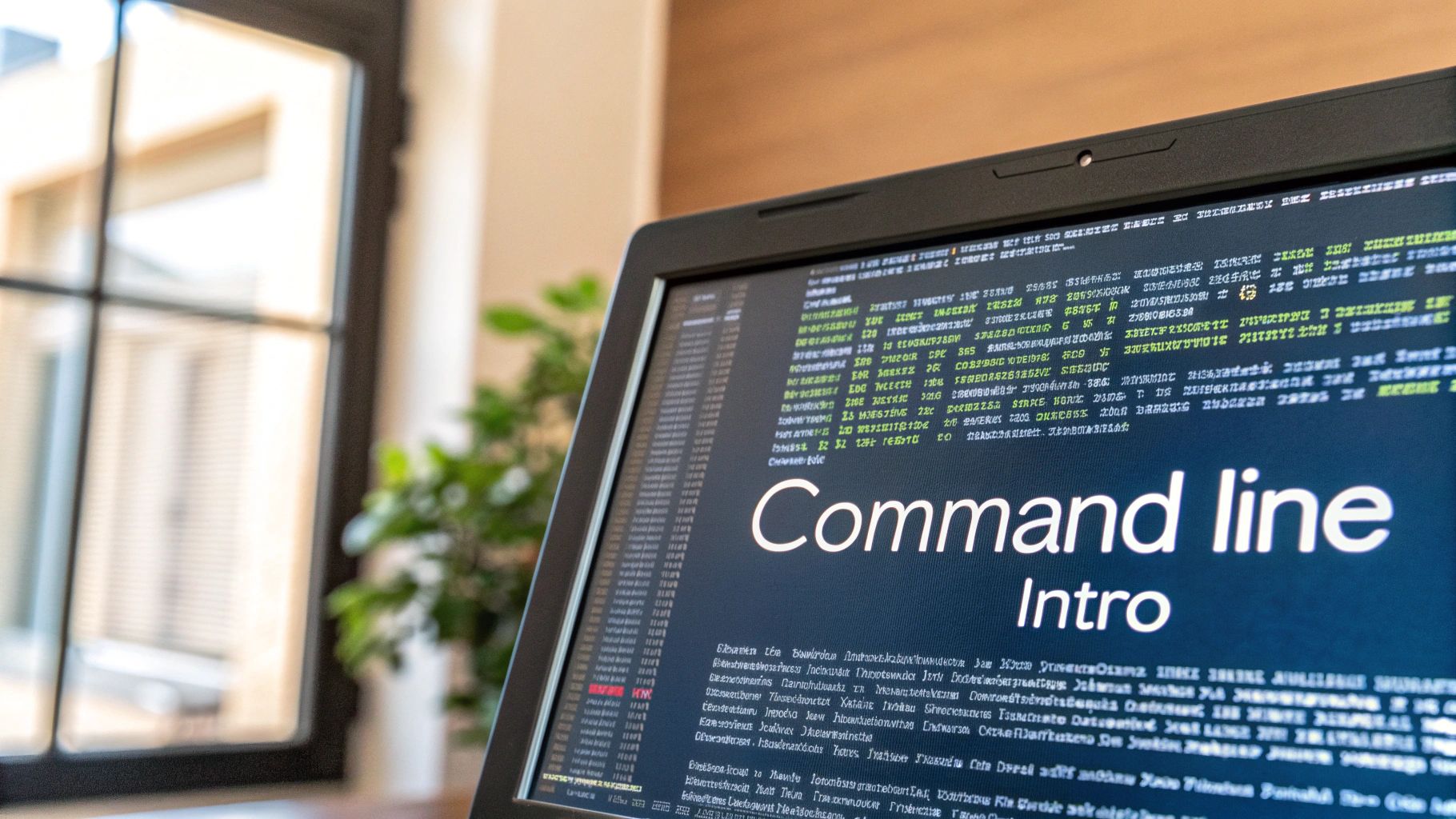Linux Command Line Basics: A Complete Guide to Terminal Mastery
Getting Started With Terminal Confidence
The Linux command line might seem scary when you first encounter it. But once you understand the basics, you'll discover it's an incredibly powerful way to control your system and get things done quickly. Let's walk through the key concepts that will help you feel comfortable working in the terminal.
Understanding the Terminal Structure
When you open a terminal window, you'll see a prompt that ends with a $ symbol. This is where you type your commands. The $ tells you the system is ready for your input. Any text you type before pressing Enter becomes a command for Linux to execute. One of the first commands you'll use is ls, which shows you all the files and folders in your current location.
Navigating the File System
The Linux file system works like a family tree, with folders branching off from a main trunk. The starting point is called the root directory, shown as /. Moving around is done with the cd command – short for "change directory". For example, typing cd Documents takes you into your Documents folder. Want to go back up one level? Just type cd ...
To avoid getting lost, you can always type pwd to see exactly where you are in the file system. Think of it as your "You Are Here" map marker. These navigation commands are the foundation you'll build on as you learn more complex operations.
Mastering Essential Linux Command Line Basics
Once you can move around confidently, you'll want to learn how to work with files and folders. Here are the must-know commands:
- Create new folders with
mkdir(make directory) - Create empty files with
touch - Delete files and folders with
rm(but be careful – deleted items don't go to a recycle bin!) - Copy things with
cp - Move or rename files with
mv
These basic commands are like building blocks. As you practice using them, they'll become second nature. The real magic happens when you start combining them to handle bigger tasks efficiently. Take time to experiment with each command – the more you use them, the more natural they'll feel. Soon you'll find yourself zipping through tasks in the terminal that would take much longer using the regular desktop interface.
Remember – everyone starts as a beginner. Focus on understanding one command at a time, and you'll be surprised how quickly your confidence grows. In the next sections, we'll explore more advanced ways to use these fundamental skills.
Mastering Essential File Operations
After learning how to move around the Linux file system with cd and pwd, it's time to explore how to work with the actual files themselves. This section covers the key commands you'll use daily to manage files effectively in the terminal. Let's dive into the essential operations that will make you more productive.
Working With Files: Creation, Deletion, and More
Managing files is a core part of working in Linux. Here are the fundamental commands you need to know:
-
Creating Files: Use
touchto create empty files – for example,touch report.txtcreates a blank text file. This is handy when you need a placeholder file or plan to add content later. -
Deleting Files: The
rmcommand removes files, but be careful – there's no undo! Typerm report.txtto delete a file. For safety, add-ito get a confirmation prompt before deletion. -
Copying Files: Copy files with
cp. The commandcp report.txt backup.txtcreates a duplicate named backup.txt. You can also copy to other folders:cp report.txt /home/user/Documents/moves it to Documents. -
Moving and Renaming: The
mvcommand does both jobs. Usemv report.txt /home/user/Documents/to move a file, ormv report.txt summary.txtto rename it.
These basic operations form the foundation for working with files. But to really get the most out of the command line, you'll want to learn some more advanced tools.
Advanced File Operations: Finding and Analyzing Files
When working with lots of files, you need efficient ways to locate and examine them. Two particularly useful commands are:
-
Finding Files: The
findcommand helps locate files based on name, size, date and more. For example,find . -name "*.txt"shows all .txt files in the current directory and below. You can search by many other criteria too. -
File Statistics: Use
statto see detailed file info like size, permissions, and timestamps. Just typestat report.txtto see all the metadata. This helps with troubleshooting and keeping track of file changes.
These tools become invaluable when managing large numbers of files. For instance, you could use them to quickly find all images modified in the last week, or locate config files larger than 1MB.
Understanding File Permissions
File permissions control who can read, write and run files on your system. They use a three-digit code where each number sets access for the owner, group and others. The chmod command changes these permissions to control file access.
For example, chmod 755 script.sh lets the owner do anything with the file, while others can only read and run it. This ensures scripts and sensitive files stay secure while still being usable.
Getting comfortable with these file operations will make you much more efficient in Linux. Whether you're organizing documents, writing code, or managing a server, understanding how to create, find, and secure files is essential. Keep practicing these commands and they'll become second nature.
Real-Time System Monitoring Techniques
After learning basic file operations, it's time to explore system monitoring in Linux. Keeping an eye on your system's performance helps prevent issues and maintain smooth operation. Let's look at some key commands that will help you track and optimize your system's resources.
Using top for a Quick System Overview
The top command acts like a live dashboard of your Linux system's activity. It shows a continuously refreshing list of running processes, ranked by how much CPU they're using. When you run top, you'll see important stats like CPU load, memory usage, and swap space at a glance. This makes it easy to spot problematic processes – like a program that's hogging too much CPU power and needs to be investigated.
Enhancing Monitoring With htop
While top works well for basic monitoring, htop gives you a more polished and easy-to-use interface. It displays system information using colors to help you quickly spot issues. One big advantage of htop is that you can manage processes right in the program – no need to memorize extra commands. You can kill runaway processes or change their priority with just a few keystrokes, making it perfect for both monitoring and quick fixes.
Deep Dive into Virtual Memory With vmstat
When you need detailed memory insights, vmstat is your go-to tool. Unlike the process-focused views of top and htop, vmstat zeros in on memory usage patterns, including paging, swapping, and disk activity. For example, if your system keeps writing data to disk instead of keeping it in RAM, vmstat will show you. This is especially important for servers where memory problems can seriously impact performance.
Combining Tools for Comprehensive Monitoring
Each monitoring tool shows you a different piece of the puzzle. Using them together helps build a complete picture of your system's health. Start with top or htop to find resource-hungry processes, then use vmstat to check if memory or disk speeds are causing slowdowns. Think of it like a mechanic using different diagnostic tools to check a car's engine. By regularly checking these stats, you can catch and fix small issues before they become big problems. This helps keep your system running smoothly and prevents unexpected downtime.
Text Processing That Actually Makes Sense
Beyond just monitoring system health, Linux commands give you powerful tools to work with text directly in the terminal. You can search through files, make bulk edits, and analyze data – all from the command line. Let's look at how grep, sed, and awk help you process text efficiently.
Searching for Needles in Haystacks with grep
Need to find specific text in files? That's where grep (Global Regular Expression Print) shines. Instead of manually scanning thousands of lines, you can quickly locate what you need. For example, to find all "error 404" entries in a log file, just run: grep "error 404" access.log. grep also supports pattern matching with regular expressions, perfect for finding dates, IP addresses, or other formatted data in large files.
Stream Editing with sed
While grep helps you find text, sed (Stream Editor) lets you modify it on the fly. Think of it as search-and-replace with extra features. Want to update configuration files? Try this: sed 's/old_string/new_string/g' input.txt > output.txt. This command finds every instance of "old_string", replaces it with "new_string", and saves the result to a new file. sed makes quick work of text cleanup and formatting tasks.
Advanced Text Processing with awk
awk takes text processing to the next level as a complete programming language. Sure, it can do simple edits like sed, but it really shines with structured data like CSV files. Want to calculate averages from a spreadsheet column? awk handles it easily. This makes it perfect for analyzing data and creating reports right from your terminal.
Combining Text Processing Commands
The real magic happens when you combine these tools using pipes (|). You could use grep to find specific log entries, pipe them through sed to clean up the format, then use awk to calculate statistics – all in one command. This ability to chain commands together helps you automate complex tasks that would take ages with other tools. It's what makes the Linux command line so efficient for text processing.
Building Powerful Command Combinations
We've covered the basics of Linux commands for navigating files, managing directories, and monitoring system resources. Now let's explore how to combine these individual commands into powerful workflows that can automate complex tasks. This is what makes the command line such a useful tool for both beginners and experienced users.
Understanding Pipes and Redirection
The magic of command combinations comes from connecting commands using pipes and redirection. These simple operators let you chain commands together in creative ways:
-
Pipes: The pipe symbol (
|) sends output from one command directly into another command as input. For example, to see just the last 10 lines of a log file, you can pipecatintotaillike this:cat access.log | tail -n 10. This saves you from having to view the entire file first. -
Redirection: The redirection operators (
>and>>) let you save command output to files instead of displaying it. Use>to create or overwrite a file, and>>to add to the end of an existing file. This makes it easy to save command results or create logs. For instance:uname -a > system_info.txtsaves system details to a file.
Combining Commands for Practical Tasks
Once you understand pipes and redirection, you can start building useful command combinations. Need to find large files and sort them by size? Combine find, du, and sort like this: find . -size +1M -exec du -b {} \; | sort -n. Each command handles one specific job, but together they solve a more complex problem.
Automating Tasks with Shell Scripts
For tasks you run regularly, shell scripts let you save command sequences in a file to run whenever needed. A shell script is just a text file with commands that run in order. Make it executable with chmod +x script_name.sh and you can run it like any other command.
Consider a real example: automatically backing up files and emailing the archive. You could write a script combining commands for copying files, creating compressed archives, and sending emails. This turns a multi-step manual process into a single automated task.
Building Your Own Command Combinations
The best way to learn command combinations is through hands-on practice. Start with simple two-command pipes and gradually try more complex chains. Check the manual pages (man command_name) to learn each command's options and how they work with pipes.
Here are some common tasks you can try combining commands for:
| Task | Command Combination Example |
|---|---|
| Finding and counting specific files | `find . -name "*.txt" |
| Searching for a pattern in multiple files and displaying line numbers | grep -n "pattern" *.log |
| Filtering and sorting process information | `ps aux |
| Monitoring disk usage and finding large files | `du -sh * |
By practicing these techniques and experimenting with different combinations, you'll discover powerful ways to automate your work. Soon you'll be creating custom command chains that handle complex tasks with just a few keystrokes.
Troubleshooting Like a Pro
Learning to solve technical problems is just as important as mastering the Linux command line basics. Whether you're managing a server or using Linux as your daily operating system, you need to know how to identify and fix issues when they arise. Let me share with you the debugging skills and troubleshooting strategies that professional Linux administrators rely on.
Essential Troubleshooting Commands: journalctl, dmesg, and strace
Three core commands will help you find the source of most Linux problems:
-
journalctl: Think of this as your system's black box recorder. It stores all system events in one central location called the systemd journal. To see what's happening on your system right now, runjournalctl -xe. This shows you the latest entries with extra context and updates in real-time – perfect for catching problems as they occur. -
dmesg: When hardware acts up or drivers misbehave,dmesgis your friend. It shows messages from the Linux kernel, which are especially helpful during boot problems or when devices stop working. A simpledmesg | grep 'error'helps you spot error messages quickly. It's like asking the kernel "what went wrong?" -
strace: Want to see exactly what a program is doing?straceshows you every system call a process makes. For example,strace ls -lreveals all the behind-the-scenes work needed just to list files. This deep insight helps you pinpoint exactly where programs fail.
Common Problems and Solutions
Here are fixes for issues you'll likely encounter:
-
Permission Denied: This happens when you try to access files without the right permissions. The fix is usually simple – use
chmodto adjust file permissions. For example, to make a script runnable, usechmod +x script.sh. -
Command Not Found: Your system can't find the command in its PATH. Either type the full path to the command or add its location to your PATH environment variable.
-
Network Connectivity Issues: Start with
pingto test basic connectivity, useip addr showto check your network settings, and trytracerouteto see where network traffic stops flowing.
Developing a Systematic Approach
Good troubleshooting follows a clear pattern. First, collect data using tools like journalctl and dmesg. Next, analyze what you found to form theories about the cause. Then test those theories with targeted commands like strace. Finally, fix the problem and verify it stays fixed. This methodical process helps you solve problems faster than random guessing.
Practicing Your Troubleshooting Skills
The best way to get better at fixing Linux problems is through hands-on practice. Try breaking things in a test environment, then fix them. Set up tricky scenarios and work through them step by step. The more problems you solve, the better you'll become at spotting patterns and finding solutions quickly.
Looking to build your debugging expertise? Visit DebugBar for detailed guides and resources that will help you master Linux troubleshooting techniques.



